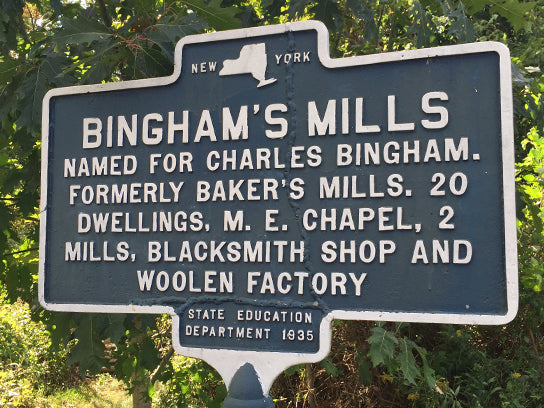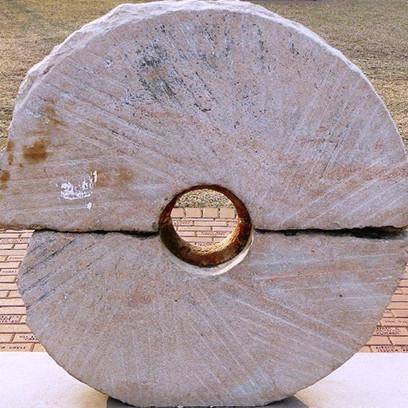When it comes to the grind, the Empire State is a powerhouse. New York is both a grower of “grist for the mill” — wheat, corn, barley, buckwheat and other grains — and the grist mills themselves. Among New York’s geographic advantages are its arable farmland and a variety of aquatic resources, from an ocean at its southeastern border to a system of rivers, streams and ponds throughout, which powered the grindstones in the grist mills of the 18th, 19th and 20th centuries.
On almost any drive throughout the state, visitors can find vestiges of New York’s grist mill past, particularly at places where towns converge with rivers or streams. Even if the mill’s edifice is long since gone, markers preserve the historic record, such as this one in Livingston on the erstwhile site of Bingham's Mills:

Four of New York's intact remnants from this once-robust era are currently listed on the U.S. Register of Historic Places, and the sites are open to visitors. They are:
The Stony Brook Grist Mill, in Long Island's Stony Brook. Built in 1751, and actively used by area farmers through the 1950s, the site is now open for guided tours led by a miller:
Photo: The Ward Melville Heritage Organization.
The Roslyn Grist Mill, in Roslyn, also on Long Island, was built between 1715 and 1741, and hosted George Washington in 1790:
Photo: Wikipedia.
The Tuthilltown Grist Mill, near the Catskill Mountains in Gardiner, is New York's oldest continuously operated water-powered grist mill and, interestingly, was a miller of Kosher matzoh flour. The site is now home to the Tuthill House at The Mill restaurant and Tuthilltown Spirits distillery:
Photo: Tuthilltown Spirits.
The Enfield Falls Mill and Miller's House, in the Finger Lakes town of Enfield, had three run of stones — for buckwheat, wheat and coarse grains — in use from 1839 to 1916, and is open to visitors of the Robert H. Treman State Park, who can view the mill en route to the Enfield Glen gorge.
Photo: Wikipedia.
To better understand the grist milling process, watch this video filmed at the mill at Stony Brook:
Inventor Oliver Evans, who spent the last years of his life in New York, revolutionized the milling process in the late-18th century with a patented, fully-automated mill design. In an ironic reversal, a Stony Brook University research team sought to make the old new again in the search for renewable energy sources. In 2010, they demonstrated with their Hydropower Project how water mills could be retrofitted to generate hydroelectricity at the 250-year-old Stony Brook Grist Mill.
New York's long grist mill history remains active thanks to businesses like The Birkett Mills, in the Finger Lakes town of Penn Yan. Operational since 1797, the business is world-renowned for its buckwheat, which was used in 1987 to produce the world's largest pancake. The 28-foot diameter griddle used in this feat is publicly mounted on a building in Penn Yan's main drag.
Lead Photo: The grist mill millstone from Grist Mill Park in Huntington, N.Y., via Wikipedia.






Leave a comment